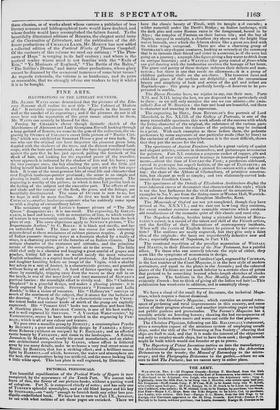FINE ARTS.
ILLUSTRATIONS OF THE LITERARY SOUVENIR.
Mn. ALARIC Warrs seems determined that the pictures of the Lite- .rary Souvenir shall realize its nevi title " The Cabinet of Modern Art." It certainly surpasses its rival the Keepsake in the beauty as well as the number of its engravings ; and if the pictures do not in all cases bear out the reputation of the great names attached to them, Mr. Warrs can scarcely he blamed for this. Passing by CHALON'S clever 'though fantastic sketch of the Marchioness of A bercorn and Lady Georgiana Russell looking through a hoop garland of flowers, we come to the gem of the collection, the en- graving by OUTRDI of COLLINS'S sweet little picture of" Rustic Civi- lity," which was exhibited at Somerset House a year or two back. No one who saw the original can have forgotten the pleasant green lane, dappled with the shadows of the trees, and the distant woodland land- .scape, with the barn and homestead ; nor the bare-legged urchin leaning against the gate that he has just opened, pulling the forelock of his shock of hair, and looking for the expected pence of the traveller, whose approach is indicated by the shadow of him and his horse ; nor the two younger ones, the boy climbing the gate, and the little girl hiding herself behind her brother, and looking out with a shy but eager look. It is one of the most genuine bits of rural life and character that ever English landscape-painter produced ; the scene is so simple and pleasing in itself, and so truly and characteristically portrayed. The engraving is worthy of the picture, to which it does full justice both in the feeling of the subject and the executive part. The effects of sun and shade and the texture of the flesh, the grass, and the foliage, are beautifully discriminated. The name of OETRIM is new to us, but we hope it will be more familiar. At first we took it for one of COUSENS'S—another landscape-engraver who has suddenly come upon US with a display of extraordinary talent. The miniature copy of LESLIE'S famoua picture of "The May Queen " disappoints us : it is too small. The engraving, by GREAT- BATCH, is hard and heavy, with an ostentation of line, to which variety of texture is too constantly sacrificed. This should have been the best plate of any. The same objections apply to NEWTON'S picture, " The Importunate Author," by C. Ror.Ls : it is black and steelly, and has tin unfinished look. The lines are too coarse for such extremely sninute detail as these miniatures of cabinet pictures require. A group of Italian peasants drawing water at a fountain shaded by a trellis of vines, is a charming picture of the luxuries of an Italian climate. The antique character of the costumes and attitudes, and the primitive nature of the occupation, give a classic air to the scene. The little child clad only in a chemise and hugging a great armful of grapes and peaches' letting fall as much as would satisfy the most voracious English schoolboy, is a capital touch of profusion. An Italian mother and daughter kneeling before an image of the Virgin, with a chubby boy asleep in a sort Of basinet, is a characteristic picture, and graceful without being at all affected. A band of fairies sporting on the sea- shore by moonlight, tripping away from the waves as they roll in on the beach, is one of the most lively and least mannered of HOWARD'S poetical fancies : the moonlight effect is vividly real. His " Chaldean Shepherd" is a graceful design, and makes a pleasing picture : it is finely engraved by DANFORTH. STOTHARD'S " Fenimorz and Lalla Rookh," is like a vision of romance. His " Hallowe'en " conveys so much of the sentiment of the subject, that it atones for the badness of the drawing. "Punch at Naples" is a characteristic scene by LTWINS : the intent looks and various kinds of mirth of the group are capitally expressed. His "Peasant Girl" looks too masculine and bust-like. A Hawking piece, by ABRAHAM COOPER, is one of his best works; and is well engraved by SHENTON. " A Venetian Water-carrier," by EDMONSTONE, seems to have been spoiled in the engraving by PER- 'LIAR ; which is all of one colour and texture.
We pass over a maudlin growls by ROMNEY; a commonplace Psyche by BEECHEY ; a poor and unintelligible design by FARRIER; a fancy- dress Rebecca (without an occiput) by F. RoCHARD ; and an affected rustic beauty by FAULKNER; and come to the landscapes. A flaming Jerusalem by MARTIN, of nearly his usual manufacture, and an elabo- rate architectural composition by GANDY, whose effect is frittered away by too many details, make us welcome a very real street scene at Roan, by ROBERTS, that has a striking effect ; and a brilliant moon- light by BARRETT,—of which, however, the water and atmosphere are the best, the composition being too artificial, and the moon looking like a little white spot. This lust plate i well engraved, by HORTON.


























 Previous page
Previous page